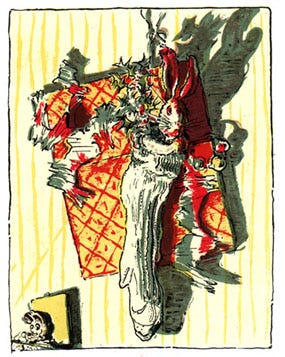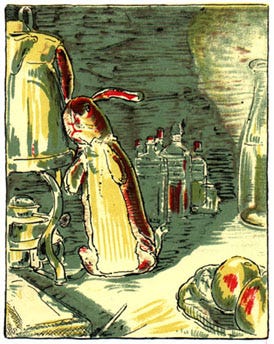On Easter, Jet received a beautiful, time-worn copy of The Velveteen Rabbit. I’ve read this book many times—most recently when Vulture did a beautiful and deep dive into the author Margery Williams Bianco’s history. Yet as I read it out loud, despite knowing how it ends and the lesson of the Skin Horse, big, hot tears began to fall. I could barely make it through the early description of the little Rabbit, hopeful and new, holding his sprig of holly without weeping.
Children’s books, especially the ones we “grow up on”, tackle big feelings in small tales. Puff the Magic Dragon, The Giving Tree, Watership Down—all of these are two-handed tear jerkers. But the existential pondering of The Velveteen Rabbit feels profound. It isn’t just a story about being loved, but about evolving and aging.
“Why is this making me so sad?” I asked Vladimir.
“Good stories make you feel real things,” he said.
“Why is this making me so sad?” I texted my friend Christian.
“It’s about the transformative power of belief and love. It’s the feeling of longing it creates that makes me cry,” they wrote.
I googled, “Why does The Velveteen Rabbit make you cry?” Reddit was filled with similar quandaries: Concern for the rabbit. The specter of death. Even fear of scarlet fever.
But when I thought about it, it was the image of that threadbare, overly loved rabbit that keep making me blubber. The loss of innocence in service to another. Having the sheen of one’s nose kissed away.
The Velveteen Rabbit starts with a brand new rabbit given as a smaller gift to a Victorian era child on Christmas. “For two hours, the Boy loved him,” the book describes, before he is passed over for newfangled toys and relegated to the back of the toy cupboard. There, he meets the Skin Horse, an upsetting term for one of those horses that was pulled on wheels at the start of the twentieth century. And the Skin Horse imparts the most famously quote portion of the book:
"Real isn't how you are made," said the Skin Horse. "It's a thing that happens to you. When a child loves you for a long, long time, not just to play with, but REALLY loves you, then you become Real."
"Does it hurt?" asked the Rabbit.
"Sometimes," said the Skin Horse, for he was always truthful. "When you are Real you don't mind being hurt."
"Does it happen all at once, like being wound up," he asked, "or bit by bit?"
"It doesn't happen all at once," said the Skin Horse. "You become. It takes a long time. That's why it doesn't happen often to people who break easily, or have sharp edges, or who have to be carefully kept. Generally, by the time you are Real, most of your hair has been loved off, and your eyes drop out and you get loose in the joints and very shabby. But these things don't matter at all, because once you are Real you can't be ugly, except to people who don't understand."
To become Real, says the Skin Horse, you must lose your innocence, you must suffer.
In many ways, The Velveteen Rabbit is the hero’s journey wrought small scale. The Skin Horse, then, is the helper/mentor who helps the Rabbit answer the call.
Not long after their discussion, the Rabbit is picked to accompany the Boy as his sleepy time comfort object. Here, the Rabbit begins to understand what it is like to be a vessel for love, having the boy rely on him for comfort and peace.
But very soon he grew to like it, for the Boy used to talk to him, and made nice tunnels for him under the bedclothes that he said were like the burrows the real rabbits lived in. And they had splendid games together, in whispers, when Nana had gone away to her supper and left the night-light burning on the mantelpiece. And when the Boy dropped off to sleep, the Rabbit would snuggle down close under his little warm chin and dream, with the Boy's hands clasped close round him all night long.
Every single one of us remembers this relationship. Mine was Lost Tiger, a tiger I found in lost & found as a little guy and I was determined to give him a home he deserved. My dear friend and old roommate Georgia had Peter, a pale rabbit that we once hid as a joke and she became livid. My step sister had a (fairly gross) “sniffy” that she held to her face every night to lull herself to sleep. Each one of us remembers our erstwhile best friend. We keep these things with us because of what they once meant to us. This belonged to someone innocent.
It is an encounter with real rabbits who are confused and fear the stuffed toy calls into question the little bunny’s conception of real, especially when he realizes he is all sewn into one piece. And while this fleeting desire allows Bianco to make the ending of this story bittersweet, as soon as the Boy picks up the Rabbit, his wild counterparts are forgotten. He goes back to being a companion to a child whose love for him is a two-way street.
Weeks passed, and the little Rabbit grew very old and shabby, but the Boy loved him just as much. He loved him so hard that he loved all his whiskers off, and the pink lining to his ears turned grey, and his brown spots faded. He even began to lose his shape, and he scarcely looked like a rabbit any more, except to the Boy. To him he was always beautiful, and that was all that the little Rabbit cared about. He didn't mind how he looked to other people, because the nursery magic had made him Real, and when you are Real shabbiness doesn't matter.
And then, tragedy strikes. The boy grows ill with scarlet fever, and “his little body was so hot that it burned the Rabbit when he held him close.” The Rabbit understood his role to protect the Boy so fully that he hid away under the sheets, even though this would be his undoing. Eventually, the Boy gets better, but an overzealous doctor insists that everything around the Boy needs to be burned—the Velveteen Rabbit especially.
As the aforementioned Vulture article writes, “Central to this transition is the limiting of the imagination to more indirect spheres of experience (dreams, literature, art) in exchange for an independent, more plastic sense of self.” The Velveteen Rabbit will lose his ability to comfort the boy, to bring the boy magic and safety, and in so doing so, he loses what makes him The Velveteen Rabbit. As he sits shivering in a trash bag, he hits his “innermost cave,” some real dark night of the soul imagery: What’s the use of becoming Real and losing all of one’s beauty if it is to end like this? The Boy’s love has made the Rabbit real, and then the Boy discards him. We feel for the Rabbit. We’ve all been the Boy.
A Deus Ex Machina fairy comes and turns the little Rabbit into a real rabbit who gets to dance and play. The rabbit becomes more real than the Boy could ever dream, and he ascends. He fulfills the call to adventure and is irreversibly changed. But this story reminds us that what is lost can never be found. Perhaps this is why we weep at The Velveteen Rabbit.
Perhaps what makes The Velveteen Rabbit quite sad is that the Hero’s Journey is quite sad. Despite receiving the ultimate boon and vanquishing the antagonizing forces, the hero can never return to whence they came. Frodo will never be satisfied in The Shire, Neo can never unswallow the red pill, and Luke’s apotheosis has made him too tortured to go back to carelessly shooting womprats. The little Rabbit, as well, can never go home again. He can never again experience the warmth of the bed of the Boy, the comfort of innocence, the magic of the burrows made in sheets.
At the very end of the story, the Boy, while playing outside, spies a familiar looking rabbit. Why, he looks just like my old Bunny that was lost when I had scarlet fever! the Boy thinks. But the Velveteen Rabbit doesn’t return to the boy, to comfort or reassure him, to prove that the love and connection between them was real.Maybe that’s why all of us remember our Lost Tigers and Peter Rabbits—to assure ourselves that those sacred relationships are indeed real. Or to assure our little stuffed lovies we carry with us, which we still remember seeing comfort behind their button eyes. See? Tears.
I think about Jet, peaceful and asleep, and all the pals I want to give her to comfort her, and the ways in which she might love them. But each one can only protect her for so long, I think, before the mystery and magic of childhood wears off and instead of becoming a treasured friend for whom burrows are built, the small capital R Rabbit transforms back into an object as the real (not the Real of the story, but the really real) comes pouring in. The loss of innocence is a real weep-fest. Even if it is just a small, stuffed bunny who has been loved into its own demise.






A tender story, and a tender essay. Thanks.